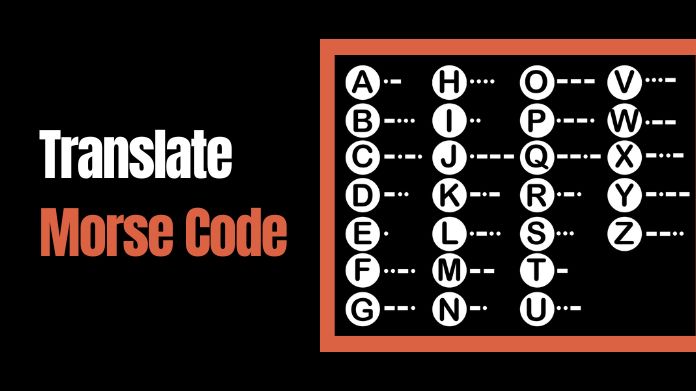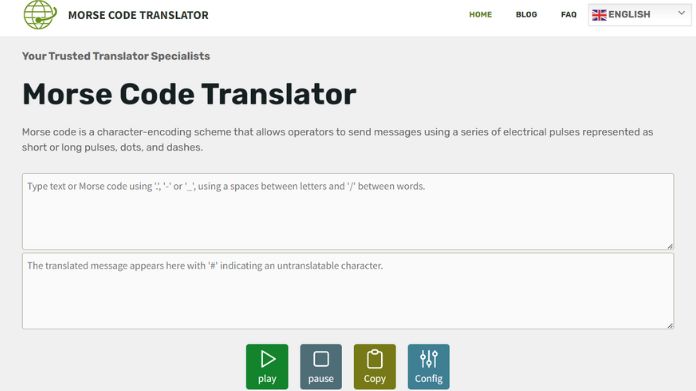In the intricate world of communication, Morse code stands as a timeless and fascinating method, using dots and dashes to convey messages.
The ability to translate Morse code unlocks a doorway to a unique language that has played pivotal roles in history, from maritime communication to wartime strategies.
In this More Code Translator guide, we delve into the art of translating Morse code using a Morse code translator, unraveling the cryptic patterns of dots and dashes to reveal their messages.
Join us on a journey into Morse code, where every pause and pulse tells a story waiting to be unveiled.
What is Morse Code?
Morse Code is a communication form that uses a sequence of dots and dashes to express letters and numbers. Samuel Morse and Alfred Vail developed it in the early 1830s for the telegraph, which allowed for long-distance communication using electrical signals.
Each letter and number in Morse Code is represented by a unique combination of short signals (dots) and long signals (dashes), with pauses in between to indicate the spaces between letters and words.
Morse Code was widely used for telegraphy until more advanced communication technologies were invented. However, it is still occasionally used today in specific contexts, such as amateur radio communication and military applications.
Morse Code Translators: An Overview

Morse code is a historical testament to the power of simplicity and precision in the vast communication landscape.
Morse code translators are indispensable tools in the modern era, bridging the gap between this traditional language of dots and dashes and our contemporary understanding.
This section provides a comprehensive overview of Morse code translators, exploring the various types available and offering insights into choosing the right one for your needs.
Types of Morse Code Translators
1. Online Translators
The digital age has brought about a plethora of online Morse code translators. These web-based tools enable users to input Morse code or text, swiftly generating accurate translations. Explore the convenience and accessibility offered by these virtual translators.
2. Mobile Applications
As smartphones become ubiquitous, Morse code translation apps have become popular. Discover the functionalities and user-friendly interfaces that these mobile applications bring to the palm of your hand.
3. Manual Methods
Manual Morse code translation methods still hold significance for those who appreciate a hands-on approach. Uncover traditional techniques that involve decoding Morse code using pen and paper, sound, or light signals.
Choosing the Right Translator
1. User-Friendly Features
Navigating through the myriad of Morse code translators requires understanding user-friendly features. Delve into considerations such as ease of use, clear interfaces, and additional functionalities that enhance the overall user experience.
2. Accuracy and Reliability
The effectiveness of a translate Morse code lies in its accuracy and reliability. Explore factors influencing translation precision, including algorithm robustness, error correction capabilities, and the translator’s ability to handle different input formats.
Embark on a journey through the evolving landscape of Morse code translation, where technology and tradition converge to preserve and propel the language of dots and dashes into the future.
How to Use Morse Code Translator to Translate Morse Code?

To utilize a Morse code translator, follow these steps:
1. Go to our Morse code translator tool online. There are multiple websites and mobile applications available that can assist with this.
2. Once you have selected a translator, open the tool on your preferred device.
3. Next, input the text to convert into Morse code. This could be a word, phrase, or even a complete sentence.
4. Ensure that the language setting is set to English or the desired language for translation.
5. Click the “Translate” button to initiate the conversion process.
6. The tool will generate the Morse code equivalent of your inputted text. It will typically display the Morse code symbols using a combination of dots (.) and dashes (-).
7. Take note of the generated Morse code translation and use it as desired. You can copy and paste it, write it down, or even play it audibly if the translator tool has that functionality.
8. If you need to decode Morse code back into regular text, ensure the translator tool has a decoding option. Input the Morse code symbols; the tool will convert them into understandable text.
Following these steps, you can easily use a Morse code translator to convert text into Morse code and vice versa.
Troubleshooting Morse Code Translation
As we navigate the intricate world of translate Morse code, occasional challenges may arise that require a keen eye and strategic approach.
This section explores common troubleshooting scenarios, offering insights into overcoming obstacles and enhancing the accuracy of Morse code translation.
Common Translation Issues
1. Ambiguities in Interpretation
Morse code, with its simplicity, can sometimes introduce ambiguities in interpretation. Unravel the complexities associated with deciphering Morse code messages that may pose challenges due to spacing, timing, or signal clarity variations.
2. Dealing with Noise and Disturbances
External factors such as ambient noise or signal distortions can impact the accuracy of translate Morse code. Explore strategies for mitigating the effects of environmental disturbances, ensuring a precise and reliable decoding process.
Enhancing Translation Accuracy
1. Adjusting Settings
Morse code translators often come equipped with customizable settings. Learn how tweaking parameters such as speed, tone, or spacing can optimize translation accuracy, catering to individual preferences and environmental conditions.
2. Refining Manual Techniques
Refining techniques are crucial for enthusiasts engaged in manually translate Morse code methods. Discover effective pen-and-paper strategies and innovative approaches involving sound and light signals to elevate the precision of manual decoding.
Navigate the intricacies of Morse code troubleshooting, equipping yourself with the knowledge and skills needed to overcome challenges. As you delve into the art of decoding, these insights will serve as valuable tools to ensure a smooth and accurate translate Morse code experience.
Final Words
Mastering Morse code translation goes beyond decoding dots and dashes; it involves embracing the language’s rich history and discovering its endless possibilities.
Adopting the language means appreciating its simplicity and understanding the cultural significance embedded in each signal.
As we conclude this exploration, Morse code is more than a relic of the past—it opens doors to fun learning activities, real-world applications, and creative innovations.
Whether decoding messages in a game or using it practically, Morse code invites us to explore, learn, and appreciate the timeless art of communication. Each dot and dash tells a story, asking us to uncover the secrets and potential woven into this enduring code.
